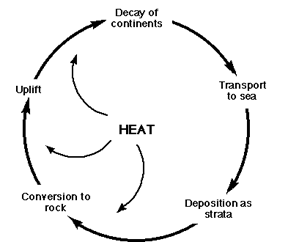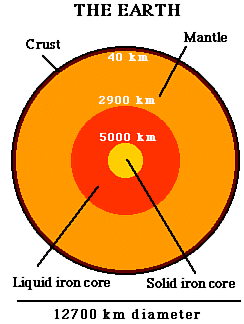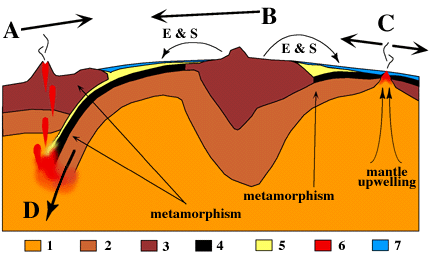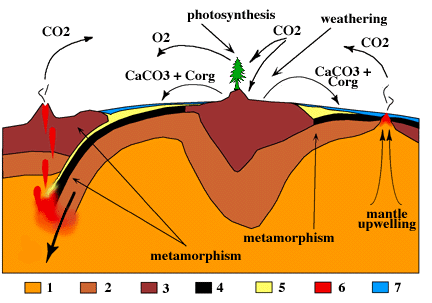| What special properties does life have?
1. Life is active chemical system separated from its surroundings
and out of chemical equilibrium with its surroundings. Chemical equilibrium
= death.
|
 |
BACK
TO DINOSAURS 2001 HOME PAGE
There is a small
project assigned for this lecture.
I. We have seen how a few principles could allow us to deduce history from geometry, fossils, and radiometric dates; how evolution works, and how we can assess the relationships of organisms.
II. So, we see that organisms have evolved and diversified and that indeed produces the order in the fossil record, which we can use to deduce relative time.
Much of the rest of the course will deal with the relationships of organisms, notably dinosaurs.III. Lets look at the earth. What we see is a function of life itself - maintaining the atmosphere and regulating Earth's temperature, even the color. How does that happen?But organisms also interact with each other and with their surrounding environment. This aspect, which is ecology, has a very special set of effects.
| What special properties does life have?
1. Life is active chemical system separated from its surroundings
and out of chemical equilibrium with its surroundings. Chemical equilibrium
= death.
|
 |
These properties of life produce the world as we now know it. As we shall see, the composition of the atmosphere, and our climate, and perhaps even the structure of the Earth's surface itself is due to life processes within the Earth System.
 |
V. FIRST, LET'S LOOK AGAIN AT HUTTON'S CYCLIC VIEW OF THE EARTH
- Largely correct, he postulated the Rock Cycle. This cycle produces the
major rock types:
1). Sedimentary Rocks - Rocks formed from sediment, precipitation from solution, or the products of organisms. Examples: sandstone, rock salt, coal. 2). Igneous Rocks - Rocks formed from hot molten material. Examples: basalt, diabase, granite. 3). Metamorphic Rocks - Rocks formed by the profound alteration of other rocks by the effects of heat and pressure. Examples: marble, slate, schist. |
VI. We now know that the reason that the rock cycle happens
as a cycle - indefinitely - is because of "plate tectonics".
Plate tectonics are a consequence of the existence of large sheets or "plates" of solid rock crust, more-or-less floating on a more liquid or plastic mantle. As a consequence of deep movements within the mantle the plates move, separate from each other and crunch into each other.If we look in detail at a near-surface cross section of the Earth, we see that the crust is not everywhere of the same thickness. |
 |

In the above diagram; 1 is asthenospheric mantle, 2 is lithospheric mantle, 3 is continental crust (mostly granite in composition), 4 is oceanic crust (mostly basalt), 5 is sediment in the ocean basins, 6 is erupting igneous material (lava when it is at the surface), and 7 is ocean water. A, B, C, and D show the direction of plate motion. C is an oceanic rifting zone where new oceanic crust is created by upwelling asthenospheric mantle which reaches the surface and turns horizontally. An example is the Mid-Atlantic Ridge. D is a subduction zone, where old, cold crust sinks below an overriding plate. Erosion and sedimentation (E & S) transfers sediments weathered from the continental crust to the ocean basins where it accumulates. At D, the old crust and the sediments that were deposited are being subducted. As they sink they heat up and eventually melt. The melt contains a lot of water and gas and rises to the surface to erupt as volcanoes. Mt. Fuji in Japan is such a volcano riding above the subducting Pacific plate. Another example is Mt. St Helens. Some material gets scraped off by the overriding plate and added to the continental crust in mountains that bears the volcano. The cycle of the creation of new oceanic crust at C (a so-called spreading ridge) and addition to continental crust by scraping off material from old oceanic crust at the subduction zones (above D) and that added to continental crust by subduction-produced igneous material (6 at D) about balances the loss of crust by subduction. The movement of the plates themelves is thought to be due to circulation of the asthenosphere and/or pull of the sinking, subducting plates.
The motion of the plates has occured throughout earth history and changed the configuration of the continents and oceans though time.
VII. Thus the plate tectonic cycle is responsible for the Rock Cycle and is why it makes sense.
SEDIMENTARY ROCKS
- are produced by the burial of material eroded from the continentsIGNEOUS ROCKS
- are produced either by mantle upwelling, such as at spreading ridges, or by subduction-related volcanosMETAMORPHIC ROCKS
- are produced mostly by the heating and deformation of sedimentary or igneous rocks where subduction is taking place, or where burial depths get very greatVIII. NOW THIS IS WHERE IT GETS INTERESTING - The atmosphere composition is tied in as well to this cycle.
The Atmosphere consists of:
Mostly Nitrogen = N2 (78%)CO2 was 0.0250% in 1800 and now 0.0360 % - an over 30% increase 100 years - all due to humans burning fossil fuels!
Second Oxygen = O2 (21%)
Third Water Vapor = H2O (<1% to 4%)
Fourth Argon = Ar (1%)
Fifth Carbon Dioxide = CO2 (<0.1%) (0.0360%) now
Sixth Methane = CH4 (1.7 ppm = 0.00017%)
1. O2 we need to breatheThat is, it lets sunlight in which converts to heat, but it does not let the heat out. This is the same principle that glass is effective in a greenhouse.
2. CO2 plants needCO2 is a greenhouse gas
IX. WHERE DOES THE O2 COME FROM AND WHAT CONTROLS ATMOSPHERIC CO2 ??
In the world at large any fixed carbon not respired by animals, fungi, or microbes goes into sediments.THIS CARBON THAT GETS BURIED MEANS A LOSS OF CO2 TO THE AIR AND AN EQUIVALENT ADDITION OF O2Plants through photosynthesis convert CO2 to C in Carbohydrates (CH2O) CO2 + H2O + E = CH2O + O2 (where E is energy from light)the reverse process is respiration: we eat carbohydrates and use O2 to get energyCH2O + O2 = CO2 + H2O + EPhotosynthesis on land and in the water is important.
X. CO2 IS ALSO CONSUMED BY THE WEATHERING PROCESS:
Water reacts with CO2 to produce carbonic acid. Carbonic acid reacts with Calcium and Magnesium silicate rocks to yield Calcium Carbonate (CaCO3 - limestone!) (or Magnesium Carbonate = MgCO3 = Dolomite) and Silicon oxide (SiO2 - quartz!).
CO2 + CaSiO3 = CaCO3 + SiO2 orTHUS, WHEN THESE CARBONATES ARE BURIED IT REPRESENTS A LOSS OF CO2 FROM THE ATMOSPHERECO2 + MgSiO3 = MgCO3 + SiO2
These carbonates and the quartz get buried as sediments, mostly in the ocean basins.
But where does the CO2 come from in the first place?
It comes from the lava and gasses coming up at spreading ridges and subduction zones.
In fact most of the CO2 at subduction zones comes from the metamorphism of the very materials that consumed the CO2 in the first place - Carbonates reacting with Quartz, for example:SO THE CO2 GOES IN A BIG CYCLE THAT TAKES MILLIONS OF YEARSCaCO3 + SiO2 = CO2 + CaSiO3The Calcium Silicates (CaSiO3) come back out as lava adding to continental crust, and the CO2 comes out of the volcanos as explosive gas!
We can see this by adding the Carbon cycle to the plate tectonic
diagram:

In the above diagram, Corg is organic carbon, primarily the breakdown products of carbohydrates produced by photosynthesis.
THUS, THE ATMOSPHERIC CO2 IS JUST WHAT REMAINS BETWEEN THE OUTGASSING CO2 FROM IGNEOUS AND METAMORPHIC SOURCES AND CONSUMPTION OF CO2 BY PHOTOSYNTHESIS AND WEATHERING.
XI. IT IS SENSITIVE TO THE RATE AT WHICH WEATHERING OCCURS. WHAT KEEPS THE SYSTEM STABLE?
The long term carbon cycle is a system with built-in feedback mechanisms. One that has long been proposed is quite simple.
Suppose the plate tectonic cycle sped up so that more CO2 was being released into the atmosphere? If weathering rates and photosynthesis remained constant, CO2 would "pile up" in the atmosphere. But CO2 is a green house gas - the more CO2 there is the more heat gets trapped in the atmosphere and the warmer it gets.The same kind of relationship holds for photosynthesis.Chemical reactions, however, run faster as it gets warmer.So, as it gets warmer, the chemical reactions of weathering increase and more CO2 gets consumed, so lower atmospheric CO2 levels result. It is a negative feedback.Suppose, now, that the plate tectonic system slows down so very little CO2 is added to the atmosphere; what happens?
As it gets colder because of the reduced CO2 in the atmosphere, the chemical weathering reactions slow down.CO2 now "piles up" because its consumption has dropped.
If photosynthesis increased wildly for some reason, O2 would go up because more organic carbon would be buried.In addition to supplying O2 though carbon burial, plants also act to "fertilize" weathering. Carbonic acid comes not only from water reacting with atmospheric CO2 but even more important is the carbonic acid produced from CO2 in the soil. CO2 is much more concentrated in the soil because of the respiration of plant-produced organic matter by microbes, fungi, the soil fauna, and plant roots themselves.But if O2 goes up things burn easily (forests are close to self-imolation all the time now). The increase in forest fires would decrease photosynthesis.
Thus the more land plant photosynthesis there is, the faster the weathering - all again subject to negative feedback. If too much CO2 is removed it gets too cold for plants to live, plant-mediated weather decreases and the CO2 can build up again.
Doesn't this suggest that whatever affects the long-term distribution of plants will also effect atmospheric CO2? - it sure does, as we will see in subsequent lectures.
OBVIOUSLY LIFE IS CRITICAL TO THE MAINTENANCE OF OUR ATMOSPHERE
Now we can seen what I mean by life being an active chemical system separated from its surroundings and out of chemical equilibrium with its surroundings.
If there were no photosynthesis, all of the O2 would combine with reactive minerals and organic matter. CO2 would build up in the atmophere in exact proportion to the lack of carbon burial. We would end up with a super-greenhouse effect and end up more like Venus.The only time organisms are in chemical equilibrium with their surroundings is when they are dead: thus, Chemical equilibrium = death.
Our own Greenhouse problem from the burning of fossil fuels has a quite interesting relationship to the long term carbon cycle.
Presently nearly all of the organic carbon produced by photosynthetic organisms gets respired by animals, fungi, and microbes. Only the tiniest bit gets buried. But this is enough not only to maintain the O2 levels at a more or less steady state, but over geological time it is directly responsible for the formation of fossil fuels.
EVERY BIT OF OIL, GAS, AND COAL IN THE WORLD IS THE RESULT OF TINY AMOUNTS OF ORGANIC CARBON BEING BURIED BY ESCAPING BIOLOGICAL RESPIRATION.
We are increasing CO2 in the atmosphere by burning the accumulated carbon of 3.5 billion years of Earth's history. This is resulting in an increase in global temperature called " global warming". There is still much debate however.THERE IS A THEORY CALLED GAIA THAT ARGUES THAT LIFE ACTIVELY AND PURPOSEFULLY MAINTAINS LIVABLE CONDITIONS ON EARTH. THIS IS A SCIENTIFIC HYPOTHESIS PROPOSED LARGELY BY THE SCIENTISTS JAMES LOVELOCK AND LYNN MARGULIS.
The theory argues that there are many feedbacks that evolved though time that regulate the abiotic processes, maintaining our planet's livability. Research on this topic has just begun.It is an attractive proposition however, and in some circles has almost religious connotations and certainly political ones. See
GO TO THE LONG TERM CARBON CYCLE FOR A MORE THROUGH DISCUSSION OF THESE PRINCIPLES.I recommend that you surf the web for more on these subjects!
Ferns and their allies reproduce with alternation of generation. The fern you see is the so-called sporophyte generation. It produces spores which float though the air, land and sprout into green liver-like gametophytes, which shed egg and sperm into water which unite with eggs to produce the next sporophyte generation.By the late Devonian the seed was invented. Here the sporophyte plant produces a male gametophyte which becomes a pollen grain, which floats in the air to the female gametophyte, still attached to a sporophyte. The male gametophyte puts down a pollen tube, fertilizing the egg in the female gametophyte. An embryo develops with a storage of food in a hard capsule, which we call a seed.They need water to reproduce, which is why they are most abundant in wet areas.
No water needed for this reproduction. Trade off is that dispersal is slower since the seed is so very much bigger.XI. But vascular plant material is tough stuff. Once buried the lignin in woody material hardly breaks down at all. Early on in the Devonian and in the next period, the Carboniferous, there is hardly anybody big around to eat the woody matter.Now the locus of the Earth's biomass shifts from the sea to the land.
By the late Devonian there is a fairly diverse soil community, very similar to what we will see when we look at modern soils later on. Mites, spring tails, millipedes and lots of carnivores to feed on them.
Some sucking insects, a very few leaf biters, even rarer wood burrowers.As a consequence of the burial of this organic matter, O2 levels probably reached our current levels in the Carboniferous, but were kept from going higher by fire and the burial of nutrients.In the late Devonian amphibians evolve and by the middle Carboniferous we have the origin of the Amniotic egg, which frees terrestrial vertebrates from the water in the same way the seed does for plants.
But even towards the end of the Carboniferous, there are no full-time vertebrate herbivores - just a few with teeth that could handle some leafy or fruity tissue. In fact the terrestrial vertebrate community was dominated by carnivores - with the base of the food chain being aquatic, not land plant based. If you look at just the land animals the food pyramid looks upside down.
It is during this time that the rate of burial of terrestrial plant matter dramatically increases as seen in the delta 13C curve. Some say this is due to the development of vast swamps. In swamps, the decay of vascular plant matter is impeded by burial in water-saturated conditions, preventing aerobic decay.But I believe this is due to the lack of abundant herbivory which now mills down vascular plant matter to high-surface-area bits that can be readily attacked by bacteria, fungi, and small soil animals.
Hence the ecosystem efficiency of the terrestrial world was low and carbon accumulated in a much wider range of environments than now.

The above figure shows Phanerozoic CO2 levels. The curve represents the results of a geochemical model of CO2 and the bars are the range of paleo-CO2 measurements based on soil calcium carbonate.XII. During the peak of land plant spread, in the Late Carboniferous (300 million years ago), the world plunged into a long glacial age, almost certainly due to plant-mediated weathering.The plants also fertilized the chemical weathering process which almost certainly massively increased the burial rate of inorganic carbon as carbonate. The enlargement of the pool of carbonate in the oceans kept the equilibrium levels of CO2 in the atmosphere much lower.
Perhaps we came out of this glacial world in the Permian because
of the evolution of many new herbivores. Vertebrate herbivores finally
become more abundant than carnivores and for the first time the familiar
ecological pyramid is recognizable.
A major driving force for this other, than the terrestrial vertebrates, were certainly the insects and termites which may well have evolved in the Permian.We moved from the ice house to the greenhouse.Ecosystem efficiency rose, the burial of plant matter slowed, and chemical weathering slowed.
XIII. The end of the Permian saw the greatest mass extinction of all time. Raup has estimated that perhaps 99% of all species went extinct.
The origin of this mass extinction is unknown, however, there is speculation that massive amounts of CO2 and sulfuric acid released by the massive volcanism that produced the Siberian Traps (basalts) may have contributed by causing sever climatic disruption.Whatever the origin of the great end-Permian mass extinction, the following period ushered in the Age of Dinosaurs.